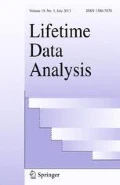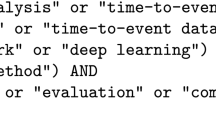Abstract
We present a new method for estimating a change point in the hazard function of a survival distribution assuming a constant hazard rate after the change point and a decreasing hazard rate before the change point. Our method is based on fitting a stump regression to p values for testing hazard rates in small time intervals. We present three real data examples describing survival patterns of severely ill patients, whose excess mortality rates are known to persist far beyond hospital discharge. For designing survival studies in these patients and for the definition of hospital performance metrics (e.g. mortality), it is essential to define adequate and objective end points. The reliable estimation of a change point will help researchers to identify such end points. By precisely knowing this change point, clinicians can distinguish between the acute phase with high hazard (time elapsed after admission and before the change point was reached), and the chronic phase (time elapsed after the change point) in which hazard is fairly constant. We show in an extensive simulation study that maximum likelihood estimation is not robust in this setting, and we evaluate our new estimation strategy including bootstrap confidence intervals and finite sample bias correction.




Similar content being viewed by others
References
Altun M, Comert SV (2016) A change-point based reliability prediction model using field return data. Reliab Eng Syst Saf 156:175–184
Antoniadis A, Gijbels I, MacGibbon B (2000) Non-parametric estimation for the location of a change-point in an otherwise smooth hazard function under random censoring. Scand J Stat 27:501–519
Callcut RA, Wakam G, Conroy AS, Kornblith L, Howard BM, Campion EM, Nelson MF, Mell MW, Cohen MJ (2016) Discovering the truth about life after discharge: long-term trauma-related mortality. J Trauma Acute Care Surg 80:210–215
Chang IS, Chen CH, Hsiung CA (1994) Estimation in change-point hazard rate models with random censorship. In: Carlstein E, Müuller HG, Siegmund D (eds) Change point problems, Institute of mathematical statistics lecture notes, vol 23, pp 78–92.
Davison AC, Hinkley DV (1997) Bootstrap methods and their application. Cambridge University Press, New York
Efron B, Tibshirani RJ (1993) An introduction to the bootstrap. Chapman & Hall, New York
Eriksson M, Brattström O, Larsson E, Oldner A (2016) Causes of excessive late death after trauma compared with a matched control cohort. Br J Surg 103:1282–1289
Gijbels I, Gürler U (2003) Estimation of a change point in a hazard function based on censored data. Life Time Data Anal 9:395–411
Gürler U, Yenigün CD (2011) Full and conditional likelihood approaches for hazard change point estimation with truncated and censored data. Comput Stat Data Anal 55:2856–2870
Kleyner A, Sandborn P (2005) A warranty forecasting model based on piecewise statistical distributions and stochastic simulation. Reliab Eng Syst Saf 88:207–214
Li Y, Qian L, Zhang W (2013) Estimation in a change-point hazard regression model with long-term survivors. Stat Probab Lett 83:1683–1691
Loader CR (1991) Inference for a hazard rate change point. Biometrika 78:749–757
Mallik A, Sen B, Banerjee M, Michailidis G (2011) Threshold estimation based on a p-value framework in dose-response and regression settings. Biometrika 98:887–900
Matthews DE, Farewell VT (1982) On testing for a constant hazard rate against a change point alternative. Biometrics 38:463–468
Müller HG, Wang JL (1990) Nonparametric analysis of changes in hazard rates for censored survival data. An alternative to change point models. Biometrika 77:305–314
Noura AA, Read KLQ (1990) Proportional hazards change point models in survival analysis. J Roy Stat Soc Ser C (Appl Stat) 39:241–253
Pouw ME, Peelen LM, Moons KG, Kalkman CJ, Lingsma HF (2013) Including post-discharge mortality in calculation of hospital standardised mortality ratios: retrospective analysis of hospital episode statistics. Br Med J 347:f5913
Schiergens TS, Dörsch M, Mittermeier L, Brand K, Küchenhoff H, Lee SML, Feng H, Jauch KW, Werner J, Thasler WE (2015) Thirty-day mortality leads to underestimation of postoperative death after liver resection: a novel method to define the acute postoperative period. Surgery 158:1530–1537
Schneider CP, Fertmann J, Geiger S, Wolf H, Biermaier H, Hofner B, Küchenhoff H, Jauch KW, Hartl WH (2010) Long-term survival after surgical critical illness: the impact of prolonged preceding organ support therapy. Ann Surg 251:1145–1153
Wang J, Zheng M, Yu W (2014) Wavelet analysis of change points in nonparametric hazard rate models under random censorship. Commun Stat Theory Methods 43:1956–1978
Yang CH, Yuan T, Kuo W, Kuo Y (2012) Non-parametric Bayesian modeling of hazard rate with a change point for nanoelectronic devices. IIE Trans 44:496–506
Acknowledgements
We would like to thank the Associate Editor and the two anonymous Referees for their careful reading of the paper and the most useful comments which greatly helped us improving it.
Author information
Authors and Affiliations
Corresponding author
Additional information
We acknowledge support of the second author by a University of Padova Visiting Scientist Scholarship 2014.
Rights and permissions
About this article
Cite this article
Brazzale, A.R., Küchenhoff, H., Krügel, S. et al. Nonparametric change point estimation for survival distributions with a partially constant hazard rate. Lifetime Data Anal 25, 301–321 (2019). https://doi.org/10.1007/s10985-018-9431-x
Received:
Accepted:
Published:
Issue Date:
DOI: https://doi.org/10.1007/s10985-018-9431-x




